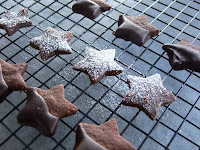Madeleines originate from France and were popularized by the author Proust in his book. They are called so after the name of the original cook. I didn't post the first batch of madeleines because I was still looking for a better recipe then.
These were from my first try. The previous recipe was too sweet that I had to double the zest and add a whole lot of lemon juice into the batter. In retrospect, adding that lemon juice was not a good idea. Too much juice (acid) can react with the baking powder (base) and create more water. Better to substitute it with lemon extract.
This time around, the new recipe yielded better tasting madeleines. I substituted 1 tsp of the vanilla extract with lemon extract. My only fault was the oven. I followed the time guideline from the recipe but the madeleines turned out more brown than the picture in the book. It's strange because they tasted fine. It's just that their colouring is wrong...Don't be put off and do try the recipe. Maybe you won't have the same problem as I did. I'll have to figure out why and get a feel of the new oven here.
 Madeleines
Madeleinesadapted from here
(makes 14 large or 36 mini cookies)
Ingredients
2/3 cup of plain flour
3/4 tsp baking powder
1/4 tsp of salt
1/2 cup caster sugar
Grated zest of 1 lemon
2 large eggs, room temperature
2 tsp vanilla extract
3/4 stick (105g) of butter, melted and cooled
pure icing sugar, for dusting
Method
- Whisk together the flour, baking powder and salt together in a medium bowl.
- Working in a large bowl, rub the sugar and lemon zest together with your fingertips until the sugar is moist and fragrant.
- Add the eggs to the bowl and with a hand mixer beat the mixture on medium speed, for 2-3 minutes, until pale, thick and light.
- Beat in the vanilla extract.
- With a rubber spatula, very gently fold in the dry ingredients, followed by the melted butter.
- Press a piece of plastic wrap against the surface of the batter and refrigerate it for at least 3 hours or up to 2 days. This long chill will help the batter form the hump that is characteristic of madeleines (what I noticed was when I immediately baked the batter on my first try, the hump was less profound).
- Center a rack in the oven and preheat to 200C.
- Butter 12 full-size (or 36 mini) madeleine molds and dust the inside with flour.
- Spoon the batter into the molds, filling each one almost to the top.
- Bake the large madeleines for 11-13 minutes and minis for 8-10 minutes, or until they are golden (see pic below) and tops spring back when touched.
- Release the madeleines from the mold and transfer to a rack to cool to just warm or room temperature.
- If you're making more batter, bake the next batch(es), making certain that you cool and then properly prepare the pan(s) before baking.
- Just before serving, dust the madeleines with pure icing sugar.















































